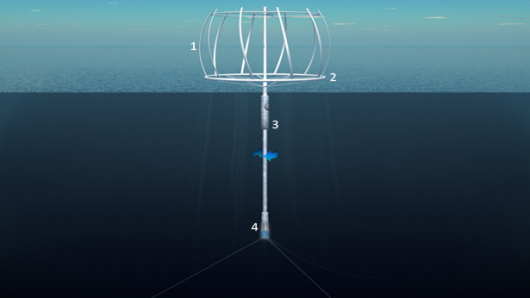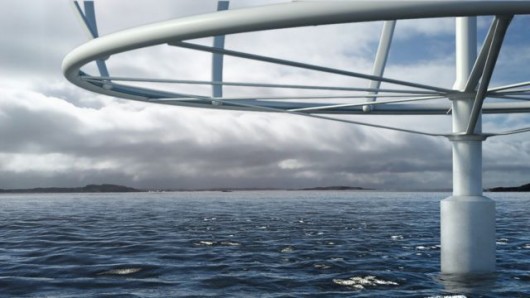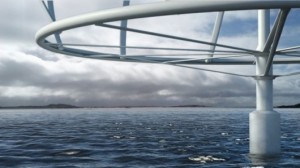One of the main drawbacks of wind turbines is the fact that for maximum efficiency, the power that they generate must be fed into the grid right as the wind is blowing and their blades are spinning. While that power can be stored in batteries for later use, some of it will always be lost in the process. Sweden’s experimental new SeaTwirl system, however, is designed to kinetically store wind energy until it’s required – it’s basically a seagoing flywheel.
The top of a SeaTwirl system consists of a vertical wind turbine, with a hollow torus ring attached to the bottom. This is the only part of the system that is located above the surface of the water.

An axle runs vertically through the center of the turbine and proceeds into the water. Mounted on that axle, just below the surface, is a hollow cylindrical float body. At the bottom of the axle is a generator. The whole system is held in place by anchoring lines attached to the bottom of the generator.
The wind causes the turbine to spin, regardless of the direction from which that wind is blowing. Because it’s attached to the turbine, the axle also spins. The water itself acts as a sort of ultra-low-friction roller bearing, allowing the turbine and shaft to keep spinning even once the wind has lessened. Electricity is generated where the rotating axle meets the non-rotating generator axis. That electricity is fed to the shore via seabed cables.

When the wind is high, the turbine’s vigorous spinning action causes water to be drawn up from the float, and into the torus ring. This added weight around the outside of the circular turbine adds to the centrifugal force, keeping it spinning longer. As the turbine slows, it folds down, and the water runs back down into the float. This drawing-in of mass is said to also help keep the turbine moving, in the same way that figure skaters start to spin faster when they draw in their arms and legs.
A one-fiftieth-scale prototype SeaTwirl was tested off the coast of Sweden in August, and it reportedly performed well. The designers claim that in its proposed 430-meter (1,411-foot)-long full-scale incarnation, a commercial SeaTwirl should be able to generate 4.5 megawatts of mean power, or 39,000 megawatt-hours per year. It could reportedly store 25,000 kilowatt-hours worth of power, which they say would be enough to support 8,000 homes for one hour.
Because much of the SeaTwirl system’s weight would be supported by the water, it is also claimed that production costs would be lower than those of present offshore wind turbines, as heavier, less expensive materials could be used.
The video below contains some animation that illustrates how the technology would work.

 Follow
Follow